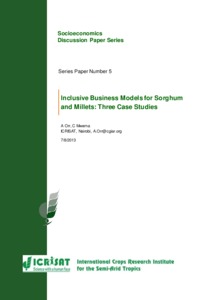Inclusive Business Models for Sorghum and Millets: Three Case Studies, Socioeconomics Discussion Paper Series Number 5
Abstract
Inclusive business models combine profitability with the potential for poverty reduction by linking smallholders with markets. This report analyses three business models relevant for sorghum and millets in east and southern Africa. These are: The Warehouse Receipt System operated by Lesiolo Grain Handlers Limited (LGHL) (Kenya), the contract sorghum grower model operated by Smart Logistics Solutions Ltd (SLS) (Kenya), and the contract finger millet grower system operated by the LEAD Project (Uganda). The performance of these business models was evaluated in terms of their design, profitability, and inclusiveness. The WRS is a producer-driven model that depends on the willingness and ability of producers to store grain until prices rise. The case-study of the WRS operated by LGHL showed low uptake by maize growers due to constraints imposed by low awareness among growers, a minimum 10 t threshold of grain accepted for storage, and the distance to the store. In 2011, only 600t of maize entered the WRS from five farmer groups. Although the WRS was profitable for maize growers, the seasonal rise in prices was much lower for sorghum and millets, which greatly reduced the potential benefits of WRS for these crops. A recent survey of participants showed that the WRS was inclusive, with high rates of participation from small maize producers and from women. The Smart Logistics business model is a buyer-driven model driven by the growing market for clear sorghum beer. Smart Logistics acts as an intermediary for the brewery industry, supplying seed to producer groups, monitoring quality, and offering higher prices than local brokers. The model is profitable for growers, intermediary, and buyer. Volumes supplied to the industry have grown but are still not sufficient to meet demand. The model is inclusive with the majority of producers belonging to all-female groups, and collective farming to reduce unit costs. Of the three models studied, this has the greatest potential. The LEAD business model was designed to provide Unga Millers Ltd in Nairobi with an annual supply of 6,000 t of finger millet. However, the model proved unworkable. No finger millet was ever delivered. The business model was profitable for Ugandan growers and for the buyer. The model was also inclusive, with finger millet supplied smallholders organized in producer organizations, where almost half the members were women. However, the model failed because it was intermediary-driven. Changes to the original design by the LEAD management team delayed the start of the project while the small company appointed to bulk, clean, and ship finger millet to Nairobi was unfit for this role

